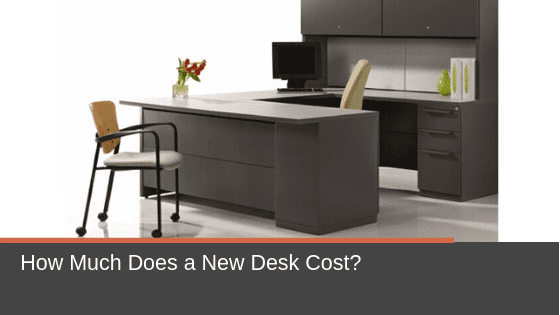Search for topics or resources
Enter your search below and hit enter or click the search icon.

What I envision when I mentally picture a desk is not necessarily the same thing as when you mentally picture a desk, so before I try to give you a cost, I’m going to first explain what I’m costing.
The office desk of today is quite different from that of 10 or 20 years ago. These days we are finding that the typical desk calls for a layout of approximately 6’x6’ in an L-shape configuration (one primary work surface with a return surface perpendicular to the primary work surface) and some amount of storage designed as an under-surface pedestal, an overhead hutch, or both.

Solid wood or metal desks have virtually disappeared and either thermofused laminate, high-pressure laminate or veneer surfaces have become the norm.
You should typically count on spending between $900-$7000 for a 6’x6’ desk. While the range is rather broad, ultimately, it can’t be narrowed until you answer two important questions:
So what makes one desk more expensive than another? It really comes down to two things: finish choice and storage capacity.
The amount of storage capacity incorporated into a desk or workstation is a significant factor in its overall cost. When deciding how much storage you want your desk to have, take the opportunity to really think about how much you actually need.
Since you will need to box up everything in, on and around your desk before you can move your new desk, take advantage of this situation and give your drawers a thorough purge. You may be surprised at how much can be moved to a more economical storage option that is slightly less close at hand. For example, many documents or materials that you use less than once per week can likely be moved to a high-density storage unit or filing cabinet shared by others in your office.
There are two common types of finishes for desks these days, laminate and veneer; your choice can have a significant impact on the final price you pay.
The veneer is virtually unmatched in sheer aesthetic appearance and there are thousands of combinations of shades, grains and patterns to choose from so it is entirely possible to design the exact desk of your dreams… but that aesthetic design and choice come with a price. The veneer is very much a premium finish option and is priced accordingly.
Laminate has traditionally been looked down upon as a more budget or “cheap” option, but in the last few years, there have been significant technological advances in the production and application of laminates that have gone a long way to narrow the gap between the appearance of a veneer and laminate work surfaces.
There are generally many different laminate finishes available for each product line divided into several different “grades” or levels of price. Laminate can be further divided into thermofused and high-pressure laminates. Thermofused laminate is a thin material that is applied by heat and tends to be less expensive. High-pressure laminate is a thicker material that is glued to the core and tends to be more durable.
And the finish options don’t end there. There are also a variety of edge-band materials and styles that will impact your final functionality, aesthetic, and most important to this article, final price.
Once you have established where you stand with respect to the two crucial questions discussed above you should find it much easier to estimate how much you should budget for your next desk, but what should you do next? Well, a great place to start is our Office Furniture Buyer’s Guide. It answers questions our customers ask most often, such as:
Cory Porteous
Director of Marketing & Inbound Business Development
Office Interiors
If you’re ready to start improving productivity, streamlining processes, and love the way you work through optimized workspaces and office technology, contact us today. Our team of experts is here to help!
Topics: